Just before the doors opened for day two of Bay Island Bonsai’s 16th annual exhibit, Daisaku Nomoto and Boon Manakitivipart led a critique for BIB members. Some comments focused on the displays, others on the bonsai.

Nomoto appraising a Sierra juniper
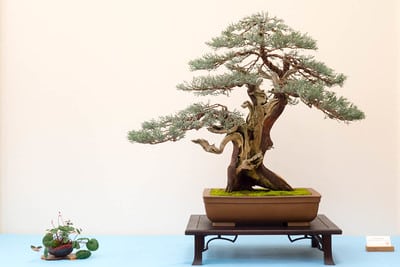
As seen from the front – Sierra juniper
Nomoto had a few ideas for improving the Sierra juniper above. He wanted the first branch on the right to be divided into two blocks of foliage instead of a single, large block. The same goes for the first branch on the left, which he also wanted to be more “compact” – a favorite phrase of Nomoto’s that he used when he wanted branches pulled down and closer to the trunk.
As the top part of the trunk is fairly straight, Nomoto suggested adding some bends. Boon added, and Nomoto concurred, that the tree could be tilted to the left.
The final comment was that the smaller branches on the tree could benefit from more bends. Straighter branches would be OK on younger trees, Nomoto said, but branches on older trees look better with curves.
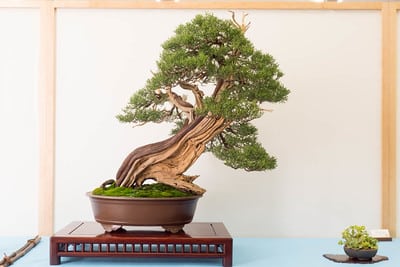
California juniper
The California juniper above could benefit from a more compact apex. And a finer point – Nomoto mentioned that the feet on the pot raised the pot further above the stand than he’d like to see. Taller feet, he suggested, make more sense for trees that don’t have so substantial a trunk.
Of the shimpaku growing on a slab below, Nomoto recommended reducing the soil area by about 40% and adding more of a slope. He really liked the stand but found it a bit deep for the tree as it extended several inches in front of and behind the slab.
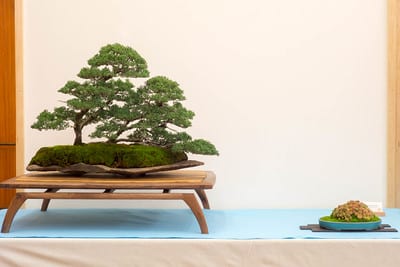
Shimpaku on a slab
When discussing the bunjin black pine below, Nomoto had us look closely at the first two branches. They currently go out and then down to form half arches. He’d like to see the branches bent down and then out. If the branches start out on a horizontal line, bending them towards the trunk – making them more compact – would result in even more of an arched shape. If the branches descend vertically from the trunk, they can be brought in without creating an arch.
Of the suiseki, Nomoto recommended a much smaller stone for the display. Of the accent, Nomoto found the foliage was a good fit with the display but wanted to see it maybe one inch taller.
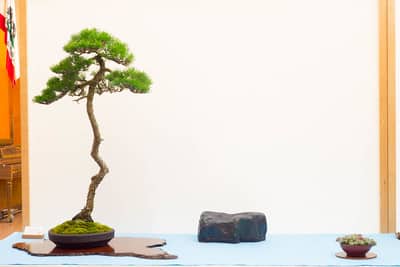
Black pine
Nomoto spent quite a bit of time discussing shohin display. For shohin, display is extra-important as the trees are often displayed in groups. He told us there are no rules, but there exist a lot of rules. In other words, while there may not be black and white rules detailing the placement of trees, there are very strong conventions.
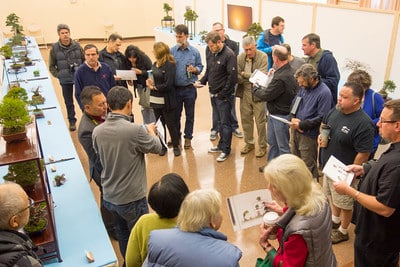
Discussing shohin display
Nomoto passed out copies of a shohin display from a recent Kokufu exhibit as an example we could learn from (p. 181 in Kokufu 88).
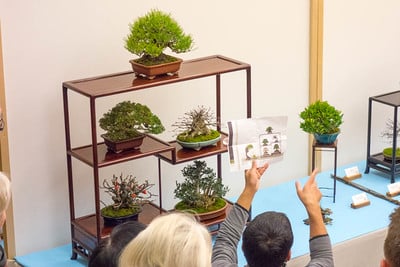
Considering a model shohin display
Some key tenets:
The most important tree sits atop the box stand (the black pine in the display below). This tree points towards the tree displayed outside of the box, the second most important tree (a gardenia). This tree points back toward the box stand to the third most important tree, the tree at the far end of the box on the bottom row (a chojubai quince). Together, these three trees form the basic triangle of the display. Getting the direction wrong on these trees distracts the viewer – better to ensure they point the right way.
Of the arrangement of deciduous varieties among conifers, Nomoto recommended placing deciduous varieties on different levels, but not one on top of the other. Thus, the Japanese maple sat in the middle row on the right, and the chojubai on the bottom row on the left.
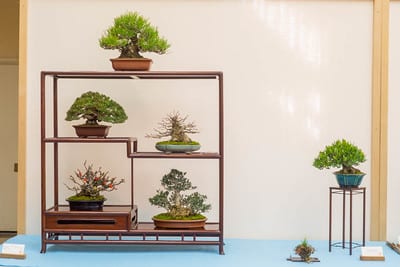
Shohin display
Below, a pomegranate, a shimpaku, a lavender serving as an accent plant, and a scroll comprise a display. Nomoto’s comment: the scroll was too low. He raised it a couple inches to the level pictured below.
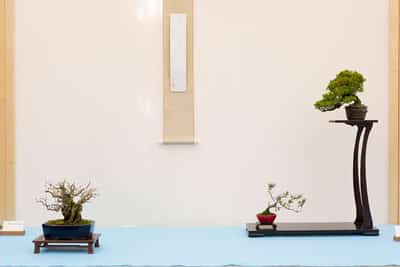
Pomegranate and shimpaku
What if both trees in a medium-sized display point the same way? Put the accent off to the side. Nomoto noted that the display below had good flow.
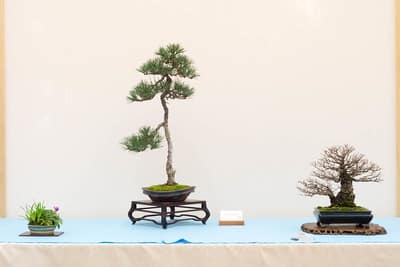
Black pine and Chinese elm
A little cotoneaster in the adjacent display could benefit from a taller stand. Nomoto recommended a small root stand to raise the tree above the accent.
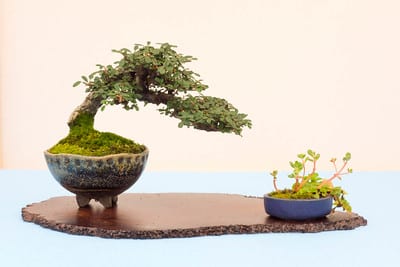
Cotoneaster
The relative size among display members also matters. Nomoto pointed out that the two trees in the display below were roughly the same size. Better the quince were smaller so the trees could be different sizes.
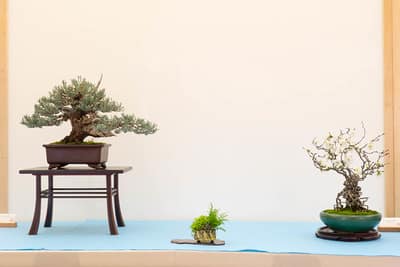
Sierra juniper, contorted quince
Then we come to stands. Nomoto wanted to see the juniper below on a lower stand – one that bore less similarity to the other stand in the display.
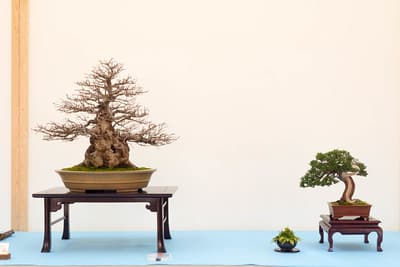
Korean hornbeam and shimpaku
Of the black pine and flowering plum below, Nomoto made the same comment he did about the Sierra juniper displayed with the contorted quince. Both trees are similar in size – better if the plum were smaller.
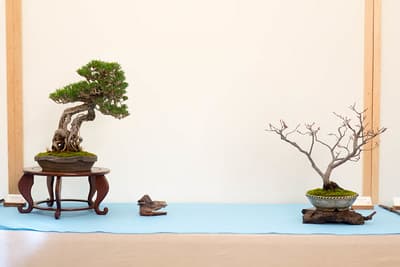
Black pine and flowering plum.
When the critique wrapped up, we sped back to our stations just as the doors opened to the public, armed with a bit of extra information to share with guests.
Subscribe to Bonsai Tonight
New Posts Delivered Every Tuesday and Friday
Joes says
Chuck
This is from the show last Sunday.
In the first picture is Boon, he started Bay Island Bonsai and is the sensei. The younger guy I think is his senior mentor, not his teacher. He started training in Japan before Boon got there. You may remember seeing them walking around.
Anyway, the critic of the trees is very educational. Give a look.
Joe
jefflahr says
One of the best blog entries that I’ve seen in a while. Thank you.